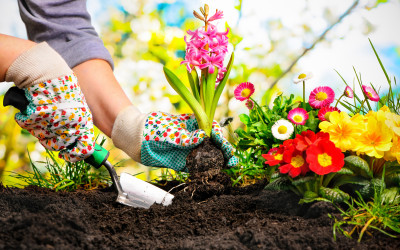Do you daydream about growing your own vegetables, flowers, and spending time in the sun digging in the soil? If you live in Ohio and have always wanted to grow your own garden, it’s time to get your hands dirty in all their gardening glory.
Timing is of the essence in a climate like Ohio’s, and depending on what you want to grow, starting your garden in early spring may be better than later in summer. But even if you’re not sure what to plant, we’ll help you start a beautiful and blossoming garden you’ll feel proud of.
Let’s begin!
Clean Up Your Yard
Like a house, your garden needs a stable foundation. Because Ohio’s soil freezes in the winter and can stay frozen well into April, you can hold off on planting until your soil is in a workable state.
You can probably see remnants of the past seasons in your yard right now ﹣ leaves, dead grass, fallen branches, and slush may all be lingering in unison. Remember: Springtime lawn care is similar to fall’s. Once the ground has solidified more, you can begin with raking the grass and picking up all the dead foliage scattered around. This will help you prepare for thatching up dead roots and stems and preparing the soil for planting.
Ohioans should spot-seed concentrated bare areas that need nutrients and attention most. Doing this early on in the springtime will give your yard a head start and lay the groundwork for when you seed later in the season.
It’s tough to predict how rainy an Ohio spring will be, so keep an eye on how much water your grass is receiving. Once your grass begins greening, you can begin fertilizing the ground.
Choose the Right Spot for Your Garden
When it comes to choosing where to plant your garden, there are some important factors to take into consideration. Make sure your garden is in a spot where it can receive at least six hours of sunshine a day. A water source should also be nearby, and your garden should be built on level ground (preferably.)
Avoid planting your garden near your house because of the shadows it can cast. If you plan on growing certain vegetables, they may require more shade. But there are other ways around this to avoid compromising your other produce, herbs, and flowers.
Before we discuss how to contain your garden, we’ll explore how to prepare your soil and finally begin your garden.
Prepare & Work Your Soil
Most areas in Ohio fall under USDA Gardening Zone 6. This means you’ll want to wait to plant most flower and vegetable seeds until the last frost, which is typically in late April and early May.
Use a soil test kit to determine whether your soil is more acidic or alkalinic. You’ll also want to examine your soil’s texture. If your soil is acidic, alkalinic, sandy, or dense, applying a special type of fertilizer or organic matter can help improve it. In typical cases, you can begin with conventional potting soil, or organic compost to give your soil a mineral boost.
Depending on what you want to grow, you may decide to create a raised or flat, in-ground beds. If your soil is healthy and uncontaminated, consider building an in-ground bed. Although they’re more susceptible to hungry critters, in-ground beds are the easiest to build and require the least amount of maintenance.
If your soil is tougher to work with and requires extra attention, consider installing raised beds. These will allow you to prevent soil contamination. Raised beds can also add an aesthetic to your yard and make it easier to separate your plants and contain them.
Once you’ve laid the foundation for your garden, you can begin digging, tilling, and cultivating your soil. These methods will begin structuring your soil and preparing them for planting.
Begin Planting & Maintaining Your Garden
In Ohio, there are cool-season vegetables you can begin planting weeks before the last freeze, such as broccoli, peas, and cabbage. Later into May, the following herbs, vegetables, and flowers grow the best in Ohio:
- Carrots
- Beets
- Spinach
- Cucumber
- Hosta
- Leadwort
- Bee Balm
- Daylily
- Black-Eyed Susan
- Lavender
- Mint
- Oregano
- Rosemary
Seedlings require daily watering. The key is to prevent your soil from drying out in the early stages. Adding mulch can help lock more moisture in, and pulling weeds and dead vegetation on a consistent basis will make more room for your garden to blossom. Keep an eye out for insect or critter infestations, and build trellis’ or stakes if you’re growing taller plants like tomatoes or sunflowers.
Create a Beautiful Garden You’ll Be Proud Of
With summer right around the corner, how will you prepare your home and yard for the best time of year? If you plan on starting a garden, be sure to share your photos and stories with us!
Follow our blog for more home and garden ideas you can look forward to this spring and summer.
Share this Post
